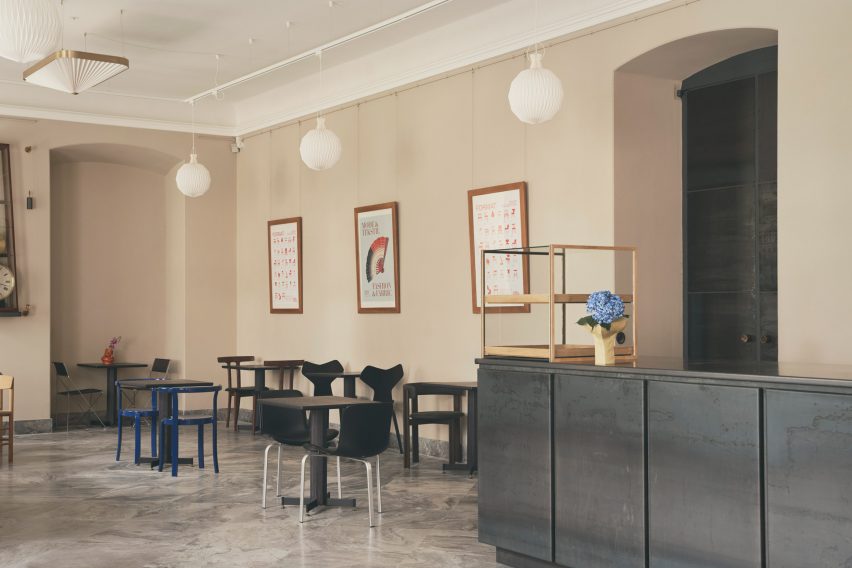
OEO Studio uses materials in a "playful way" for Designmuseum Denmark cafe and shop
Copenhagen-based OEO Studio has created a cafe and shop interior for Denmark's Designmuseum using stone, steel and wood to honour architect Kaare Klint's original design.
OEO Studio worked with materials and colours that reference Klint's design from the 1920s and added details such as custom-built cabinets to the shop and a "monolithic" steel serving counter to the cafe.

The interior design was part of a major two-year renovation of the Designmuseum, which showcases Danish design. It is located in a building from the 18th century that was renovated and adapted into a museum by Klint and architect Ivar Bentsen.
While OEO Studio didn't make any structural changes, the studio added some major interventions to the museum's interior.

"The large arched doors inside the museum have undergone a drastic change and have been covered in hot-rolled steel, present in the entrance way and in the museum cafe," OEO Studio head of design and founding partner Thomas Lykke told Dezeen.
"A huge monolithic serving counter made of steel and wood is the primary fixed piece in the cafe," he added. "As for the museum shop, the major changes are custom-built cabinets filling out the arches in the walls."

Lykke and Anne-Marie Buemann, OEO Studio managing partner, designed the 240-square-metre cafe and lounge space and the 140 square-metre museum shop to be based on Klint's simple, "ascetic" design.
"We were inspired by Klint and his almost ascetic touch on design with his clean lines – subtle yet majestic at the same time," Lykke explained.

As well as the six-metre-long bespoke counter, made from oiled oak and hot-rolled steel, the studio also designed custom cafe tables, high tables and counter-style seating for the museum's all-day eatery.
The cafe also features a selection of chairs by well-known Danish architects and designers, such as Hans J Wegner and Arne Jacobsen, with the mostly wood and steel furniture contrasting against a grey stone floor made from original tiles that were reused.
"We defined a material palette that complimented the building and the architecture," Lykke said of the studio's design.
"Materials were also chosen for their durability and their ability to age beautifully," he added.
"A mix of hard materials, as well as more soft and warmer materials, were used, including steel, wood, leather, stone, and textiles. The materials have been used in a playful way – still not over-shining the architecture. "

In the museum shop, OEO Studio reused glass cabinetry designed by Klint and added custom-built cabinets.
Small islands display books and other museum items for sale, while the built-in wall cabinets showcase sculptures and other accessories.
In both the cafe and the shop, OEO Studio used a colour palette designed to compliment the building itself.

"For the colour scheme our intention was to create a palette that naturally blended well with the original building and the materials used," Lykke explained.
"The stone tiles on the floor have a major presence in the museum – beautiful and rich," he added.
"The use of hot-rolled steel with its bluish tones creates a beautiful contrast to the tiles and the old plastered walls with their original colour. The special blue-grey paint was carefully created to complement the architecture and floors."

The studio also created a 35-metre boardroom for the Designmuseum, which can accommodate up to 10 people and features furniture that the studio designed for Stellar Works.
All of the furniture was built by Danish makers from materials sourced locally.
"Materials of high durability, quality and a design that allows for hard use over many years were important factors," Lykke said.

The Designmuseum reopened during the annual Danish design festival 3 Days of Design, when it also unveiled a translucent pavilion designed by Henning Larsen in the garden outside of the museum.
Homeware brand Vipp also showcased new architecture during the festival, with a renovation of a former garage.
The photography is by Christian Hoyer.